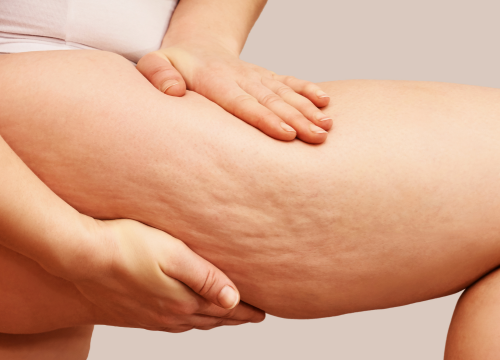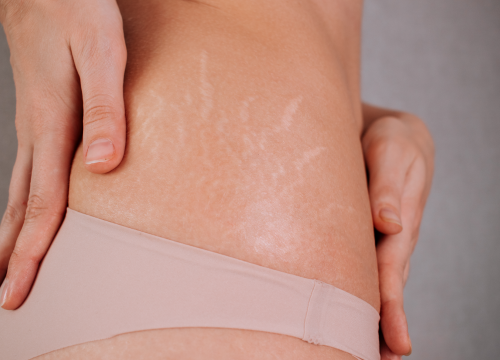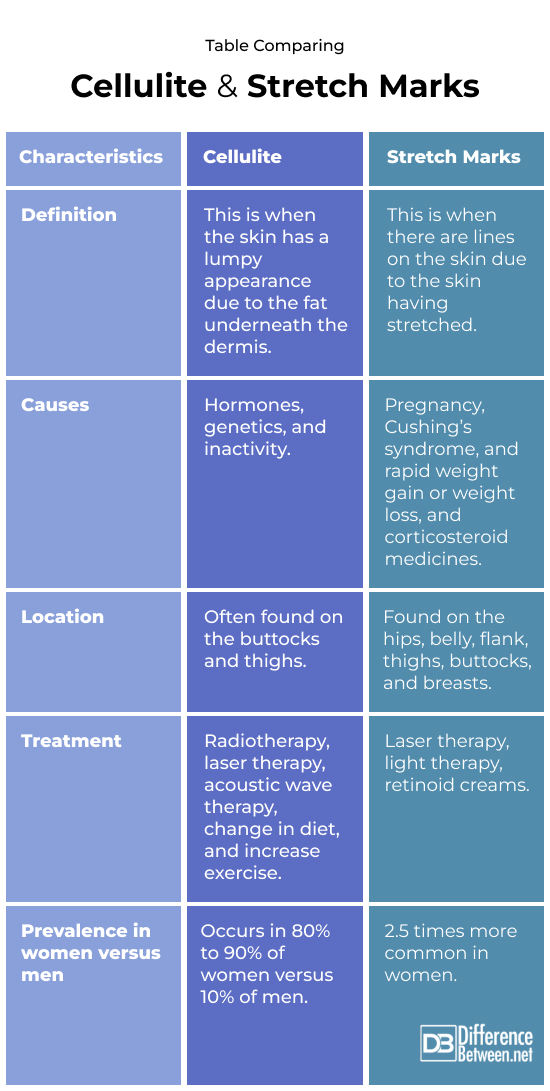Difference Between Cellulite and Stretch Marks
Cellulite is fatty tissue under the dermis that gives skin a dimpled or lumpy look. Although it can occur in males, it is far more common in females. About 8 in 10 women will have cellulite, which is partly because of how fat is distributed in women. Hormones may play a role as cellulite first begins to appear in girls during adolescence. Stretch marks are also more common in women than men and are due to the skin stretching. Pregnancy is a major cause of stretch marks in women, with such marks occurring in many parts of the body such as the hips, thighs, breasts, and belly.
In short, cellulite and stretch marks both affect how the skin looks but neither is a harmful condition. There are some treatment options for both conditions that you can try help to improve the appearance of the skin.

What is Cellulite?
Definition:
Cellulite is fat that gives the skin a lumpy, orange-peel appearance because of how this fat is deposited beneath the skin. Cellulite is also known as gynoid lipodystrophy. This condition is more common in women than men due to the different way that adipose and connective tissues are deposited in the body of females. It also first begins after puberty, suggesting that changes in hormones play a role in cellulite development. Cellulite is not something that is of harm to you, but may make you feel a bit self-conscious.
Treatment:
You can do something about cellulite by exercising, weight loss, and dietary changes. There are treatments such as acoustic wave therapy, laser therapy, and radiofrequency therapy that can also improve the appearance of your skin for a couple of months. Ultimately, cellulite is not dangerous but you can do something to make the skin look smoother.

What are Stretch Marks?
Definition:
Stretch marks occur when the skin has been stretched and appear as dark lines on the skin. These lines or striae may be pink, red, or black in color, and are common in pregnant women. Occasionally, stretch marks can be due to a condition like Cushing’s syndrome. If you have other symptoms as well as these marks, you should see your doctor to check you do not have some underlying condition. Corticosteroid medications can also sometimes result in striae on the skin. Another cause of stretch marks is if you quickly lose weight or gain weight.
Treatment:
Stretch marks are not harmful to you but they do affect how the appearance of your skin. You may not even need to do anything because stretch marks will often fade in appearance over time. If you are concerned about the appearance of your skin because of having stretch marks, you can try some treatment options like microneedling, laser therapy, or light therapy. There are also retinoid creams you can apply to the stretch marks to help diminish their appearance.
Difference between Cellulite and Stretch Marks?
Definition
Cellulite is the fat under the dermis that gives the skin a lumpy, orange-peel appearance. Stretch marks are when there are lines on the skin due to the skin having stretched.
Causes
Cellulite is due to a combination of factors, such as hormones and genetics. Stretch marks are due to Cushing’s syndrome, pregnancy, or rapid changes in weight.
Location
You can find cellulite on the buttocks and thighs. You can find stretch marks on the breasts, belly, thighs, hips, and buttocks.
Treatment
Treatment options for cellulite include acoustic wave therapy, radiotherapy, laser therapy, and lifestyle changes. Treatment options for stretch marks include laser therapy, light therapy, and retinoid creams.
Prevalence in women versus men
Cellulite occurs in 80% to 90% of women and 10% of men. Stretch marks occur about 2.5 times more often in women than in men.
Table comparing Cellulite and Stretch Marks

Summary of Cellulite Vs. Stretch Marks
- Cellulite is fat deposited under the skin that gives your skin an orange-peel appearance.
- Stretch marks are lines that form on the skin when it stretches.
- Both stretch marks and cellulite are more commonly found in women than men.
FAQ
Is cellulite a skin or fat?
Cellulite is fat that gives the skin above it a specific lumpy appearance.
What can be mistaken for stretch marks?
Sometimes cellulite is mistaken for stretch marks, but the marks do not appear lumpy but rather as lines on the skin.
Can cellulite go away?
Cellulite does not just go away on its own.
Are stretch marks from fat or muscle?
Stretch marks happen because there is a quick growth, whether of fat, or muscle.
Will cellulite go away if I lose weight?
Losing weight may make cellulite less noticeable but it never totally goes away.
Why do I have cellulite if I’m skinny?
Cellulite is not caused by weight but rather it is due to your genes and hormonal factors.
Can you tighten cellulite?
You can help tighten cellulite by strength training exercises. Exercises that target problem areas like the thighs can help make cellulite less noticeable.
How I actually got rid of my cellulite?
There is no method to totally rid you of cellulite but there are treatments to help make it less obvious.
How do models get rid of cellulite?
Body makeup is often used by models to make it look like there is no cellulite, even though it is likely present. Photos in magazines are also usually retouched and manipulated to make the skin look smooth.
- Difference Between Rumination and Regurgitation - June 13, 2024
- Difference Between Pyelectasis and Hydronephrosis - June 4, 2024
- Difference Between Cellulitis and Erysipelas - June 1, 2024
Search DifferenceBetween.net :
Leave a Response
References :
[0]Mayo Clinic. “Cellulite”. Mayo Clinic, 2024, https://www.mayoclinic.org/diseases-conditions/cellulite/symptoms-causes/syc-20354945
[1]Mayo Clinic. “Stretch marks”. Mayo Clinic, 2024, https://www.mayoclinic.org/diseases-conditions/stretch-marks/symptoms-causes/syc-20351139
[2]Tokarska, Kamila, et al. "Cellulite: a cosmetic or systemic issue? Contemporary views on the etiopathogenesis of cellulite." Advances in Dermatology and Allergology/Postępy Dermatologii i Alergologii 35.5 (2018): 442-446.
[3]Image credit: https://www.canva.com/photos/MAEBQLquYQY-cellulite-on-a-woman-s-thigh/
[4]Image credit: https://www.canva.com/photos/MAFbAhMhZBQ-woman-touching-her-stretch-marks-female-hips-with-a-stretch-marks/
